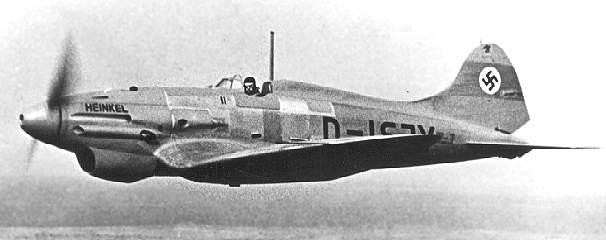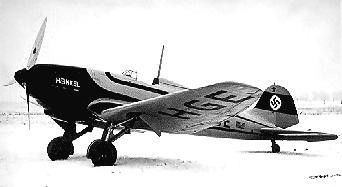He 112 Took Only Second Place
By Karl-Heinz Kens
In November 1937 the Austrian trial flights for a new single-seat fighter resulted in a
big surprise. The Austrian purchasing commission headed by the Federal Air Force
Commander-in-Chief Alexander Lohr, decided on the He 112. Test Pilot Hans Schalk
was given the opportunity to try out the Bf 109 as well as the He 112 D-IGSI. He felt
that both models performed the same. However, the Heinkel had more balanced
steering pressures and better equipment possibilities.
Austria placed an order for 42 models at a price of Reichsmark 163,278 each. This was a
late acknowledgement of the Heinkel competitor, which had been lost the competitionfor
the new standard single seat fighter for the German Air Force.
An invitation to tender for the new fighter had gone out to the industry in February 1934.
As expected Heinkel and Arado, the Reichswehr's classic fighter suppliers, were asked by the Reich's Aviation Ministry (RLM) to respond to the tender and design an aircraft which was to perform as follows: It had to travel at a horizontal speed of 400km/h at an
altitude of 6,000 meters for 20min time spans within the 90min the entire flight lasted.
The Bayrische Flugzeugwerke Bavarian Aircraft Manufacturers (BFW), which were hardly known at that time, were also competing. The designs, showing a low-wing monoplane made of metal and fitted with a retractable undercarriage, were comparable but Arado's design which was fitted with a fixed undercarriage was eliminated from the competition at an early stage. However, in other ways the BFW and the Heinkel differed considerably. The Heinkel Team with twin brothers Walter and Siegfried Günter as Project Leaders and Karl Schwärzer as Construction Leader had not been too adventurous. Their He 112 was a carefully worked out construction as far as the aerodynamics were concerned. It consisted of a double spar wing, which spanned 12.6 meters and measured 23.2m2, a wide landing gear, which could be retracted inside and an open seat for the pilot. Because of the wing design, the strain on this area could be kept below the 100kg/meter2 limit.
At BFW the Team Leader Willy Messerschmitt and his Project Leader Rober Lusser, who had left Klemm, managed to achieve something with the Bf 108 which even the reknowned light aircraft specialist Klemm did not manage straight away. For the European round trip 1934, he designed and constructed a touring aircraft, which had a cabin with four seats, sticking to a very low weight limit of 560kg in its unloaded state. The aircraft was entirely made of metal and fitted with a retractable undercarriage. Bearing in mind the experiences with the Bf 108, the light single-seater Bf 109 was developed. The wing span measured almost 10 meters and had an area of 16m2, which resulted in an area strain of 113kg/m2.
Proving flights of the prototypes of the two competing models which were both fitted initially with the British Rolls-Royce-Kestrel-V-Engine (510kW), took place in Travemünde from 8 February 1936 with the He 112 V1 D-IADO. A few days later, proving flights with the Bf 109 V1 D-IABE followed. Initially traditionalists were in favour of the Heinkel model. However, they were impressed by the Bf 109 V2, which had by then been fitted with the Junkers-Jumo-210-Engine, as intended for mass production, and which had been transferred to Travemünde by Dr. Ing. Hermann Wurster on 21 February 1936. After Heinkel-Top Pilot Gerhard Nitschke had transferred the Jumo 210-Engine to Travemünde on 15 April, the He 112 V2 was also fitted with this engine. When he made a demonstration flight, the aircraft went into a spin and the pilot had to get out. However, the competitor also had its fair share of misfortunes. When the Bf 109 V1 was transferred to Rechlin, it crashed and had to be rebuilt for demonstration flights.
Both models were being tested and compared until October 1936. On 30 September four He 112 were being tested. The models differed considerably. Heinkel knew whom to blame. He himself had been unable to be the driving force behind the development, because he was busy fulfilling several government contracts. He was therefore forced to put Dr. Ing. Heinrich Hertel of the German Test Centre for Aviation in charge and make him technical director leading the developments of the aircraft in 1934. He later declared Hertel to be a man, who was compelled to experiment and come up with numerous test variations of the same aircraft. He had employed Hertel in 1933 to be his technical assistant in developing the bomber He 111, and then promoted him one year later to reward him for his successful work. Hertel has without doubt had some success when working for Heinkel. However, while he was working on the He 112, his drive to change the fighter turned into a craze. Finally a number of various prototypes and pre-production models flew, although the He 112 was never produced in its A-series. Hence the decision for the Bf 109 was an easy one, especially since the leadership of the German Air Force had supported it to develop and strengthen Bavaria's aviation industry. One was keen to establish a big factory by the end of 1933 in Augsburg.
Germany's Air Force was on its own with the idea of a standard single seat fighter. All the other important air forces preferred to have two or more different models. By restructuring the He 112, which was supposed to lead to the B-Series, Heinkel hoped to change the RLM's decision. The first realised version, the He 112 D-IGSI, was practically a new construction with an oval wing, reduced wing span and profile thickness, an elongated slimmer fuselage and a closed clear view cabin. It had two MG 17 in the side walls of the fuselage and two 20-mm-Mk in the wings. This model was later to be tested and chosen by the Austrians.
At the beginning of April 1938 Captain Harro Harder took the aircraft to Spain to test it at the front, where it received the code 8-2 for the time being. An unarmed prototype from the A-Series had already been tested in the Spanish War from December 1936. Successful sorties were flown by the Unit VJ/88 against tanks with a 20-mmMG-C/30L canon, until the fighter crashed during an emergency landing in June 1937. The Legion Condor deployed only these two He 112.
As directed by the RLM the German aircraft export, which amounted to RM20mio in 1929/30, had been reduced drastically to observe secrecy and because of the German Air Force's own demand. All this changed when foreign currency and raw materials became scarce and one had to reconsider export radically. From the summer of 1939 export became extremely important, although the people responsible found it hard to concede.
When Heinkel had to accept that it was impossible to sell the He 112 to the Luftwaffe, the sales team
approached the foreign market. Connections with Japan had traditionally been good and in autumn
1938 24 models were ordered with options for more. The first twelve aircraft reached Japan in spring
1938 and the rest were promised for May. However, because of the crisis in Sudetenland the German
Air Force requisitioned the dozen aircraft. They were passed as the IVth Group to the JG 132 until they
were replaced by Bf 109s in October. When Japan refused to accept the late aircraft, the National Spanish
Air Force took them on and ordered a further five. The last aircraft arrivedHe 112 a month after fighting
had finished. Despite this the Spanish Ace Garcio Pardo managed to shoot down a republican fighter during
his first deployment on 19 January 1930. However, during victory celebrations on 31 March he collided with
another He 112 and lost his life. The remaining aircraft stayed with the troop.
The Hungarian Air Force would have liked to have the He 112 B, but Germany had to refuse the first order
over 38 models at the beginning of 1938 because of neutrality in Hungary's and Rumania's dispute over
Transylvania. Finally the Hungarian Manfred-Weiss Company was to manufacture the model under license.
On 1 June 1939 Hungary ordered twelve examples from the licence holder and three further models from
Heinkel. These were handed over in August. Hungary's attempts to have more powerful DB-601 or Jumo-211-
Engines installed in the models, which were constructed under license, were resisted by Germany and lead to
the cancellation of the project.
The Rumanian Air Force was to order the last He 112 B. The date of the contract was 18 August 1939. The 30 planes were being supplied until 30 September. Although they were no match for the Russian counterparts during deployment, they stayed at the front line until the beginning of 1944.
The He 112's engine was simply not powerful enough. The RLM did not give permission to replace the 20liter Jumo 210 with one of the new 30liter engines. She was never allowed to show her true potential. Trials with the DB 601 and especially with rocket engines demonstrated how well this model could have performed. This is how the He 112 remained, as the Spaniard Garcia Pardo had put it, "the Rolls-Royce among aircraft with the wrong engine".



